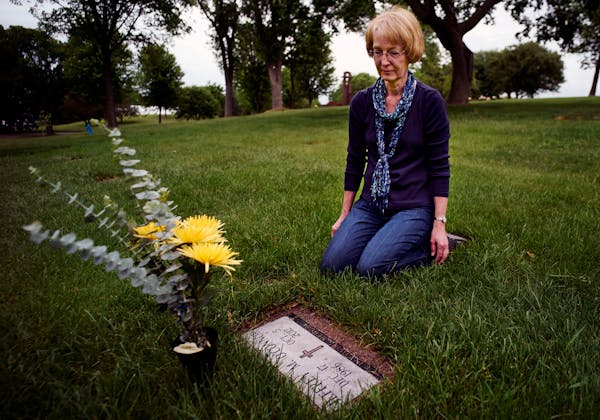Within a year, metro area counties will be testing a single mental health crisis number that should make a request for help with mental illness as easy as calling 911.
From Colorado to Tennessee, states across the country have developed statewide mental health numbers. But Minnesota's would take a different twist, using a cellphone's geolocation to route the call to that county's crisis line rather than require a caller figure out which of dozens of numbers to call.
The system is "really cutting-edge technology" and could be the first of its kind in the nation, said Kay Pitkin, administrative manager of Emergency Mental Health Services in Hennepin County. "It will make crisis services more easy to access."
Officials with the Minnesota Department of Human Services (DHS) said that metro area counties will pilot the new crisis line within a year before it is implemented statewide by 2018 or 2019.
Funds for the line are part of a historic $46 million investment made in 2015 by the Legislature and Gov. Mark Dayton to boost the state's mental health system, the largest such investment in state history.
Instead of calling police or going to an emergency room, an increasing number of people are turning to crisis lines, where social workers can help de-escalate a crisis and assess the situation. A mobile crisis team can then go to the person's home to help manage and stabilize the situation, such as providing help with insurance paperwork or helping to arrange therapy.
But experts say there are still many Minnesotans who don't know crisis lines exist or which number to call. That's why the state chapter of the National Alliance on Mental Illness (NAMI) last year supported the creation of a single number and why the organization is frustrated that it still hasn't launched.
"We had hoped it would start by now," said Sue Abderholden, the state chapter's executive director. "It's an important piece of building our mental health system."
In a statement, the DHS said that it expected the statewide phone line to take several years and that the department was on track with the work.
Expanding crisis services
One local nonprofit, Canvas Health, already runs a statewide crisis line called Crisis Connection that was established nearly 50 years ago. It gets 35,000 to 50,000 calls a year.
Most of the time, mental health professionals help someone over the phone; if a person in trouble wants a crisis team to respond, Canvas Health will reroute the call to a county mobile team.
"We think we have a better model," said Matt Eastwood, Canvas Health's chief executive.
Eastwood said the state's model assumes that most people will need a mobile team. Minnesota counties may not be able to handle the likely influx in calls, he said.
"Most of your crisis teams are already pretty stretched," he said. "If you send another 50,000 calls to them, that's going to be asking a lot."
In fact, the biggest piece of the state's 2015 mental health legislative package goes toward increasing mental health crisis services. The state has already funneled $13.6 million to individual counties to ramp up existing mobile crisis teams while helping other counties start their own, so that now every county and two tribal nations in the state have the services.
The state hopes to expand crisis services by 2018 so that teams are staffed 24/7 statewide, just as they are in most metro counties.
The teams reduce the number of more expensive hospitalizations since, according to the state, four out of five people who contact mobile services don't go to the hospital.
They also can reduce the likelihood that police are called to a mental health crisis. A Star Tribune analysis this year found that, since 2000, at least 45 percent of people who have died in encounters with law enforcement officers in Minnesota had a history of mental illness or were in crisis.
On the other hand, crisis lines won't necessarily prevent police from being involved. Mental health professionals will continue to call law enforcement officers if a weapon is involved or a person's safety is at risk; at other times, crisis responders will go with police to help de-escalate a situation.
A call for help
More people are using crisis services. In the Twin Cities, the number of crisis calls and mobile visits have risen an average of 72 percent over a period of five years, according to a Star Tribune analysis.
In Hennepin County, 75 mental health professionals annually handle more than 24,000 crisis calls and visits to adults and children. That's up from 3,154 when the crisis line service started in 2006. Even though Hennepin boosted the number of crisis responders this year, the state's most populous county still has the lowest number of crisis responders per capita in Minnesota.
In a bright, sunny office in downtown Minneapolis, Hennepin County social workers answered calls Friday from residents from across 45 cities, calmly helping identify what they need and making sure they're safe.
Unlike 911 dispatchers, they can access hospital records or previous social worker contacts along with criminal records, and they may wind up working with a resident for up to a month to stabilize the situation.
Now that Minnesota is moving toward a single crisis number, counties across the state could be fielding even more such calls from people in need.
"Let's make it simple [and] only have one number," Abderholden said. "It's an important service for families to know about."
Kelly Smith • 612-673-4141
Body camera video shows Minnetonka man repeatedly shooting at deputies before dying in firefight
Oakdale issues warning after coyote attacks dog in nature preserve

Anoka County extends search for county administrator

Minneapolis schools, teachers reach tentative agreement to avert strike

